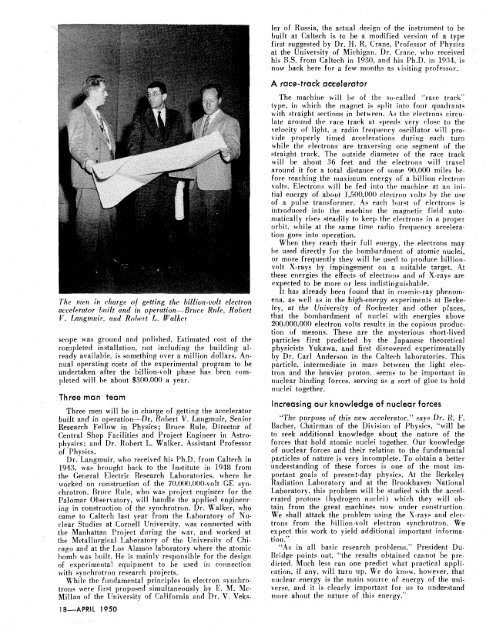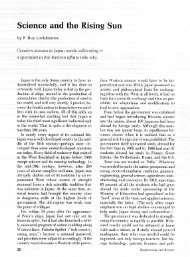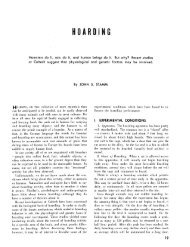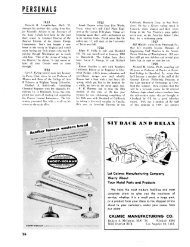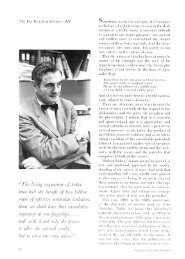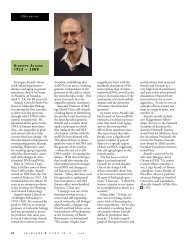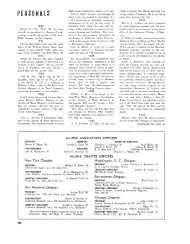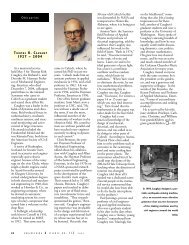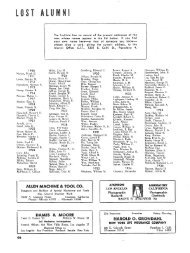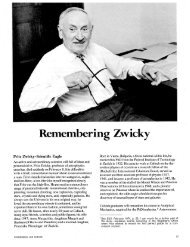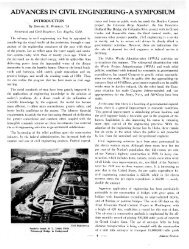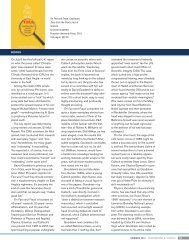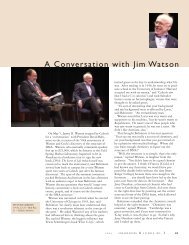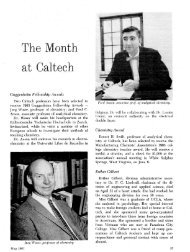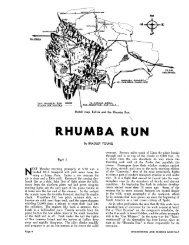T - Engineering & Science - California Institute of Technology
T - Engineering & Science - California Institute of Technology
T - Engineering & Science - California Institute of Technology
You also want an ePaper? Increase the reach of your titles
YUMPU automatically turns print PDFs into web optimized ePapers that Google loves.
The men in charge <strong>of</strong> getting the billion-volt electron<br />
accelerator built and in operation-Bruce Rule. Robert<br />
V'. 1,angmiiir. and Robert L. Walker<br />
scope was ground and polished. Estimated cost <strong>of</strong> the<br />
completed installation. not including the building al-<br />
ready available. is something over a million dollars. An-<br />
nual operating costs <strong>of</strong> the experimental program to be<br />
undertaken after the billion-volt phase has been corn-<br />
pleted will be about $300.000 a year.<br />
Three man team<br />
Three men will be in charge <strong>of</strong> getting the accelerator<br />
built and in operation--Dr. Robert V. Langmuir, Senior<br />
Research Fellow in Physics; Bruce Rule. Director <strong>of</strong><br />
Central Shop Facilities and Project Engineer in Astro-<br />
,, ohvsics: and Dr. Robert L. Walker. Assistant Pr<strong>of</strong>essor<br />
<strong>of</strong> Physics.<br />
Dr. Langmuir. who received his Ph.D. from Caltech in<br />
1943. was brought back to the <strong>Institute</strong> in 1948 from<br />
the General ~lectric Research Laboratories. where he<br />
worked on construction <strong>of</strong> the 70.000.000-volt GE synchrotron.<br />
Bruce Rule. who was project engineer for the<br />
Palomar Observatory, will handle the applied en;.. airleering<br />
in construction <strong>of</strong> the synchrotron. Dr. Walker, who<br />
came to Caltech last year from the Laboratory <strong>of</strong> Nuclear<br />
Studies at Cornell University. was connected with<br />
the Manhattan Project during the war. and worked at<br />
the Metallurgical Laboratory <strong>of</strong> the University <strong>of</strong> Chicago<br />
and at the Los 41amo~ laboratory where the atomic<br />
homh was built. He is mainly responsible for the design<br />
<strong>of</strong> experimental equipment to be used in connection<br />
with synchrotron research projects.<br />
While the fundamental principles in electron synchrotrons<br />
were first propo~ed simultaneously by E. 44. Vc-<br />
Millan <strong>of</strong> the Vriiversity <strong>of</strong> <strong>California</strong> arid Dr. V. Veks-<br />
ler <strong>of</strong> Russia, the actual design <strong>of</strong> the instniment to be<br />
built at Caltech is to be a modified version <strong>of</strong> a type<br />
first suggested by Dr. H. R. Crane. Pr<strong>of</strong>essor <strong>of</strong> Physics<br />
at the University <strong>of</strong> Michigan. Dr. Crane. who received<br />
his B.S. from Caltech in 1930. and his Ph.D. in 1934, is<br />
now back here for a few months as visiting pr<strong>of</strong>essor.<br />
A race-track accelerator<br />
The machine will he <strong>of</strong> the so-called "'race track"<br />
type, in which the magnet is split into four quadrants<br />
with straight sections in between. 4% the electron'* circulate<br />
around the race track at speeds very close to the<br />
velocity <strong>of</strong> light, a radio frequency oscillator will provide<br />
properly timed accelerations during each turn<br />
while the electrons are traversing one segment <strong>of</strong> the<br />
straight track. The outside diameter <strong>of</strong> the race track<br />
will be about 36 feet and the electrons will travel<br />
around it for a total distance <strong>of</strong> some 90.000 miles before<br />
reaching the rnavirnum energy <strong>of</strong> a billion electron<br />
volts. Electrons will be fed into the rnachine at an initial<br />
energy <strong>of</strong> about 1.500.000 electror~ volts hy the use<br />
<strong>of</strong> a pulse transformer. As each hurst <strong>of</strong> electrons is<br />
introduced into the machine the magnetic field automatically<br />
rises steadily to keep the electrons in a proper<br />
orbit. while at the same tirne radio frequency acceleration<br />
goes into operation.<br />
When they reach their full energy, the electrons may<br />
be used directly for the bombardment <strong>of</strong> atomic nuclei,<br />
or more frequently they will he used to produce billionvolt<br />
X-rays by impingement on a suitable target. At<br />
these energies the effects <strong>of</strong> electron's and <strong>of</strong> X-rays are<br />
expected to be more or less indistinguishable.<br />
It has already been found that in rosrnic-ray phenorneria.<br />
as well as in the high-energy experiments at Berkeley,<br />
at the University <strong>of</strong> Rochester and other places,<br />
that the bombardment <strong>of</strong> nuclei with energies above<br />
200.000.000 electron volts results in the copious production<br />
<strong>of</strong> mesons. These are the mysterious short-lived<br />
particles first predicted by the Japanese theoretical<br />
physicists Yukawa. and first discovered experimentally<br />
by Dr. Carl Anderson in the Caltech laboratories. This<br />
particle. intermediate in mass between the light electron<br />
and the heavier proton- seems to be important in<br />
nuclear binding forces, serving as a sort <strong>of</strong> glue to hold<br />
nuclei together.<br />
Increasing our knowledge <strong>of</strong> nuclear forces<br />
"The purpose <strong>of</strong> this new accelerator.'' sap Dr. K. F.<br />
Bacher. Chairman <strong>of</strong> the Division <strong>of</strong> Physics, "will be<br />
to seek additional knowledge about the nature <strong>of</strong> the<br />
forces that hold atomic nuclei together. Our knowledge<br />
<strong>of</strong> nuclear forces and their relation to the fundamental<br />
particles <strong>of</strong> nature is very incomplete. To obtain a better<br />
iderstanding <strong>of</strong> these forces is one <strong>of</strong> the most irn-<br />
portant goals <strong>of</strong> present-day physics. At the Berkeley<br />
Radiation Laboratory and at the Brookhaven National<br />
Laboratory, this problem will be studied with the accel-<br />
erated protons (hydrogen nuclei) which they will ob-<br />
tain from the great machines now under construction.<br />
We shall attack the using the X-rays and elec-<br />
trons from the billion-volt electron synchrotron. We<br />
expect this work to yield additional important informa-<br />
tion..'<br />
"'As in all basic research problems." President Du-<br />
Bridge points out. "the result" obtained cannot be pre-<br />
dicted. Much less can one predict what practical appli-<br />
cation. if any. will turn up. Re do know. however, that<br />
nuclear energy is the main source <strong>of</strong> energy <strong>of</strong> the uni-<br />
verse. and it is clearly important for us to understand<br />
more about the nature <strong>of</strong> this energy."


